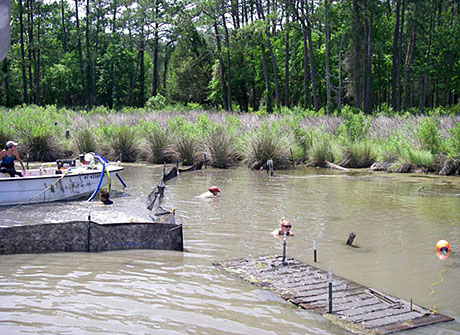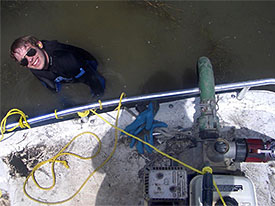
East Carolina University 2007 Field School
in Underwater Archaeology
31 May 2007
By Nadine Kopp
Today was our third day at the North Creek site, and although work on the site started slowly we have made a great deal of progress. The first day on the site we were unable to lay the baseline since the mud was so deep and our rebar was not long enough. However, yesterday we came prepared with eight foot long fence posts in order to set up the baseline. Not surprisingly the majority of the posts are under the muck, with only a little bit exposed at high tide. While Michelle, Jeremy and I did this, Larry and Calvin set up a screen around the perimeter of the site. The purpose of this was for the dredge spoil to enter this area and be contained, hopefully not re-covering our day’s work overnight. Once this was set up dredging could begin. Unfortunately only one motor was operational yesterday, which meant that we did not proceed as quickly as possible.

Mel and Nadine operate the dredges on the port side of the vessel while Jeremy watches the intake hose for sea grass accumulation and Michelle oversees the operations. (large view)
Today with both motors running we were able to have two people in the water dredging the vessel on the port side. Since boats are symmetrical objects we only need to uncover and record one side of the vessel. I spent the first half of the morning on the skiff ensuring that the motors were running properly. I often had to restart motors. I also had to shut off the motors when the intake hoses became clogged with sea grass. The area in which we are working is littered with sea grass. As you emerge from the water it drapes all over you so that along with the mud you resemble some sort of monster. Although the water intake hoses already have a cover on them to prevent objects from being sucked into the hose and blocking it, we found that the sea grass was instead blocking this cover, preventing water from entering the tube and lessening the suction power of the dredge. To prevent this from happening we also needed one person to stand at the intake hose in order that the sea grass was constantly cleared away. Yesterday Larry came up with the idea of sticking the hose into a bucket with holes so that the sea grass could not get in. This worked slightly, but someone still needed to watch over the hose.

Steve removes sea grass from the intake hose to prevent clogging. (large view)
When we broke for lunch, we all headed back to the dive barge. Interestingly, Dave had brought an egg salad sandwich. I had joked yesterday how it would be disgusting to eat an egg salad sandwich at this site. As you step up out of the mud it releases the horrific odors from deep down. These smell of sulfurous rotten eggs, which wafts across our site as we trudge back and forth from the vessel to the boat. Somehow the smell did not bother Dave, but had instead created a craving for egg salad (although he told me later in the day that he would not be bringing egg salad back to this site!).

Mel tows the skiff out of the contained dredging area after a long days work. (large view)
After lunch I had my turn at the dredge. We were able to remove a great deal of the overburden from the site, revealing that there were several collapsed layers of vessel still preserved on top of the outer hull planking. Tomorrow we should be able to begin recording some of the vessel. Hopefully we can do this without having to put our heads in this gross water. To date we have not used a single scuba tank at this site. We are now jokingly calling Mark the Dive Safety Officer our Lifeguard. It is so shallow that there is no need to go underwater. We have not even been using our gear, just our wetsuits. Not like a mask would clarify much at this site. The water is so muddy that everything will need to be done by touch.
Please feel free to contact us at mua@keimaps.com with any comments, questions, or suggestions during the weeks to come.
Return to Project Journal home page.

